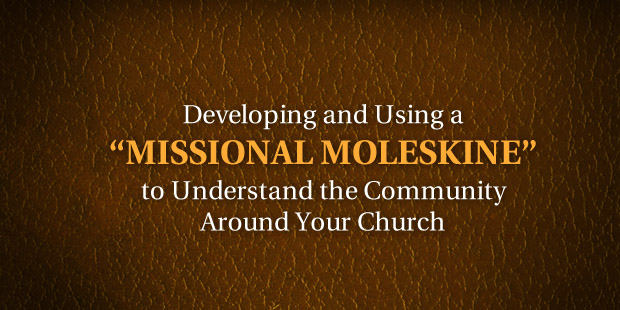
Developing a “Missional Moleskine” to Understand the Community Around Your Church
Several years ago, I was leading a group from our church in the formation of a launch team for our first daughter church plant. In my series on “cultivating community contacts,” I shared about the “missional moleskine” (not to be confused with the memory moleskine).
When I started using the missional moleskine, I used it to gather all information from people I encountered in the daily rhythm of life. Such information included:
- their name
- when and where I met the person
- what the person was doing
- info to help me remember them
- info from conversations about their life, beliefs, and experiences.
This information would then be used for ongoing prayer as well as plans to build on (cultivate) the encounters from the past. Here is how I explained it in 2008:
Once I have gathered this information, I leave room in my journal for future encounters. For example, if I cultivate a relationship with a server at a restaurant, I will schedule my eating around their work schedule and attempt to connect with them on a regular basis, building on the previous encounters and conversations. Each successive encounter would be dated and filled out, creating a chain of commentary hopefully leading to progress in loving them and leading them to Jesus. The end result is to chronicle the movement around the mission as we cultivate relationships with unbelievers and seek to sow the good seed of the gospel in their lives as a faithful witness and relentless commitment to advancing the cause of Christ. Other benefits include specifics for ongoing prayer and intercession and research/reflection for cultural exegesis, planning, and corporate strategies.
I am focusing on making disciples through a renewed relational investment plan, and with that plan, and am reincorporating the missional moleskine with a few tweaks. The big thing I’m focusing on this year is incorporating “place” and “progression” in the investment “plan“. My goal is to see the missional moleskine turn into a travelogue for life in the city. It is tracing life on mission at home (first place), at work (second place), and in the community (third places). Living as a missionary is not about being special or additional but intentional, and the missional moleskine helps me map that out.
By progress, I am talking about the establishment of relationships with non-Christians and investing in those relationships progressively over time. It is common knowledge that the majority of people whose lives are transformed by the gospel do so through a relationship. For me, this is ground zero for living on mission. While this may sound really elementary and basic, the starting point has to be an honest one.












